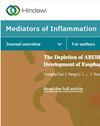表没食子儿茶素没食子酸酯对紫外线诱导的斑马鱼和人类皮肤成纤维细胞的光保护作用
IF 4.4
3区 医学
Q2 CELL BIOLOGY
引用次数: 0
摘要
背景。长期暴露于紫外线辐射(UVR)会提高氧化应激和慢性炎症水平,进而对皮肤健康产生一系列有害影响,如晒伤、光老化和皮肤癌。因此,我们决定研究表没食子儿茶素没食子酸酯(EGCG)在斑马鱼和人皮肤成纤维细胞(HSF)中缓解紫外线诱导的光老化的作用和机制。研究方法用 10 J/cm2 UVA + 30 mJ/cm2 UVB 或 25 或 50 μM EGCG 处理受精后 4 天(dpf)的斑马鱼幼体和 HSF 细胞 72 小时。用试剂盒、酶联免疫吸附试剂盒和免疫印迹法测定氧化应激、炎症和光老化指标。结果显示EGCG能保护斑马鱼和HSF细胞免受紫外线诱导的皮肤损伤。EGCG明显降低了活性氧(ROS)、丙二醛和8-OHdG的水平,提高了超氧化物歧化酶(SOD)的活性,并显著抑制了经紫外线照射的斑马鱼和HSF细胞中肿瘤坏死因子-α(TNF-α)、白细胞介素-1α(IL-1α)、白细胞介素-6(IL-6)等炎症因子的水平。我们发现,EGCG 能降低紫外线辐射诱导的 p38 丝裂原活化蛋白激酶(p38 MAPK)磷酸化,并有效抑制转录因子核因子-κB(NF-κB)的活性,从而减少蛋白-1(AP-1)、TNF-α、IL-1α、IL-6 和基质金属蛋白酶-1(MMP-1)的表达,而这些表达是导致光老化的皮肤老化级联的关键介质。结论这些结果验证了 EGCG 可保护斑马鱼和 HSF 细胞在紫外线辐射诱导下的光老化,这与 p38 MAPK/NF-κB、AP-1 信号通路的调节密切相关,这些通路可缓解氧化应激、炎症和胶原降解。本文章由计算机程序翻译,如有差异,请以英文原文为准。
Photoprotective Effects of Epigallocatechin Gallate on Ultraviolet-Induced Zebrafish and Human Skin Fibroblasts Cells
Background. The long-term exposure to ultraviolet radiation (UVR) raises oxidative stress and chronic inflammation levels, which in turn has a series of deleterious effects on skin health, such as sunburn, photoaging, and skin cancer. Hence, our study was determined to investigate the effects and mechanisms of epigallocatechin gallate (EGCG) in zebrafish and human skin fibroblasts (HSF) cells to alleviate ultraviolet-induced photoaging. Methods. The 4 days postfertilization (dpf) zebrafish larvae and HSF cells were treated with 10 J/cm2 UVA + 30 mJ/cm2 UVB, or 25, or 50 μM EGCG for 72 hr. The indicators involving in oxidative stress, inflammatory, and photoaging were measured by the kits, ELISA Kits and western blot methods. Results. EGCGs protect against UVR-induced skin damage in zebrafish and HSF cells. EGCG markedly decreased the reactive oxygen species (ROS), malondialdehyde, 8-OHdG levels, increased superoxide dismutase (SOD) activity, and significantly inhibited inflammatory factors levels including tumor necrosis factor-α (TNF-α), interleukin-1α (IL-1α), interleukin-6 (IL-6) in zebrafish, and HSF cells irradiated with UVR. We found that EGCG could reduce UVR-induced p38 mitogen-activated protein kinase (p38 MAPK) phosphorylation and effectively inhibited the activity of the transcriptional factor nuclear factor-κB (NF-κB), thereby reducing the protein-1 (AP-1), TNF-α, IL-1α, IL-6, and matrix metalloproteinase-1 (MMP-1) expressions, which are critical mediators of skin aging cascade causing the photoaging. Conclusion. These results validate that EGCG for protection of photoaging in zebrafish and HSF cells induced by UVR, which is closely related to the regulation of p38 MAPK/NF-κB, AP-1 signaling pathway which relieve oxidative stress, inflammation, and collagen degradation.
求助全文
通过发布文献求助,成功后即可免费获取论文全文。
去求助
来源期刊

Mediators of Inflammation
医学-免疫学
CiteScore
8.70
自引率
0.00%
发文量
202
审稿时长
4 months
期刊介绍:
Mediators of Inflammation is a peer-reviewed, Open Access journal that publishes original research and review articles on all types of inflammatory mediators, including cytokines, histamine, bradykinin, prostaglandins, leukotrienes, PAF, biological response modifiers and the family of cell adhesion-promoting molecules.
 求助内容:
求助内容: 应助结果提醒方式:
应助结果提醒方式:


